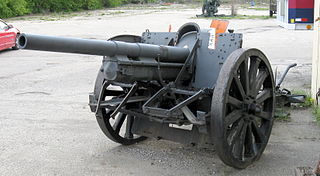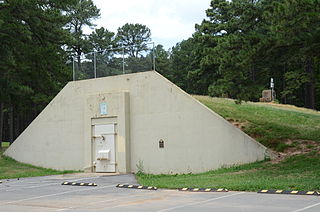
An explosive is a reactive substance that contains a great amount of potential energy that can produce an explosion if released suddenly, usually accompanied by the production of light, heat, sound, and pressure. An explosive charge is a measured quantity of explosive material, which may either be composed solely of one ingredient or be a mixture containing at least two substances.

2,4,6-Trinitrophenylmethylnitramine commonly referred to as tetryl (C7H5N5O8) is an explosive compound used to make detonators and explosive booster charges.

Picric acid is an organic compound with the formula (O2N)3C6H2OH. Its IUPAC name is 2,4,6-trinitrophenol (TNP). The name "picric" comes from Greek: πικρός (pikros), meaning "bitter", due to its bitter taste. It is one of the most acidic phenols. Like other strongly nitrated organic compounds, picric acid is an explosive, which is its primary use. It has also been used as medicine (antiseptic, burn treatments) and as a dye.
An explosive booster is a sensitive explosive charge that acts as a bridge between a conventional detonator and a low-sensitivity explosive such as TNT. By itself, the initiating detonator would not deliver sufficient energy to set off the low-sensitivity charge. However, it detonates the primary charge, which then delivers an explosive shockwave that is sufficient to detonate the secondary, main, high-energy charge.

A shell, in a military context, is a projectile whose payload contains an explosive, incendiary, or other chemical filling. Originally it was called a bombshell, but "shell" has come to be unambiguous in a military context. Modern usage sometimes includes large solid kinetic projectiles that is properly termed shot. Solid shot may contain a pyrotechnic compound if a tracer or spotting charge is used.

Styphnic acid, or 2,4,6-trinitro-1,3-benzenediol, is a yellow astringent acid that forms hexagonal crystals. It is used in the manufacture of dyes, pigments, inks, medicines, and explosives such as lead styphnate. It is itself a low sensitivity explosive, similar to picric acid, but explodes upon rapid heating.

Dunnite, also known as Explosive D or systematically as ammonium picrate, is an explosive developed in 1906 by US Army Major Beverly W. Dunn, who later served as the chief inspector of the Bureau of Transportation Explosives. Ammonium picrate is a salt formed by reacting picric acid and ammonia. It is chemically related to the more stable explosive trinitrotoluene (TNT).

A contact explosive is a chemical substance that explodes violently when it is exposed to a relatively small amount of energy. Though different contact explosives have varying amounts of energy sensitivity, they are all much more sensitive relative to other kinds of explosives. Contact explosives are a part of a group of explosives called primary explosives which are also very sensitive to stimuli but not to the degree of contact explosives. The extreme sensitivity of contact explosives is due to either chemical composition, bond type, or structure.
Ecrasite is an explosive material which is unaffected by moisture, shock or fire. It is a mixture of ammonium salts of cresol, phenol and various nitrocresols and nitrophenols principally trinitrocresol and picric acid. It was invented in 1888-1889 by two Austrian engineers named Siersch and Kubin, and used in Austria-Hungary to load artillery shells. Ecrasite was patented secretly, and its composition was once unknown.

A picrate is a salt containing the anion (O2N)3C6H2O− or an ester derivative of the picrate anion. These salts are often produced by reactions of picric acid (2,4,6-trinitrophenol). The picrate ion is intensely yellow, although many of its salts are brown or orange-red.

The 7.7 cm Feldkanone 16 was a field gun used by Germany in World War I. Most surviving examples in German service were rebarreled after the war as the 7.5 cm FK 16 nA. A total of 298 guns of the old type were still in German army service in 1939, making it the oldest field artillery piece in German inventory at the beginning of the Second World War.

Urea nitrate is a fertilizer-based high explosive that has been used in improvised explosive devices in Afghanistan, Pakistan, Iraq, and various terrorist acts elsewhere in the world such as in the 1993 World Trade Center bombings. It has a destructive power similar to better-known ammonium nitrate explosives, with a velocity of detonation between 3,400 m/s (11,155 ft/s) and 4,700 m/s (15,420 ft/s).
Explosive materials are produced in numerous physical forms for their use in mining, engineering, or military applications. The different physical forms and fabrication methods are grouped together in several use forms of explosives.

Potassium picrate, or potassium 2,4,6-trinitrophenolate, is an organic chemical, a picrate of potassium. It is a reddish yellow or green crystalline material. It is a primary explosive. Anhydrous potassium picrate forms orthorhombic crystals.
Bouin solution, or Bouin's solution, is a compound fixative used in histology. It was invented by French biologist Pol Bouin and is composed of picric acid, acetic acid and formaldehyde in an aqueous solution. Bouin's fluid is especially useful for fixation of gastrointestinal tract biopsies because this fixative allows crisper and better nuclear staining than 10% neutral-buffered formalin. It is not a good fixative when tissue ultrastructure must be preserved for electron microscopy. However, it is a good fixative when tissue structure with a soft and delicate texture must be preserved. The acetic acid in this fixative lyses red blood cells and dissolves small iron and calcium deposits in tissue. A variant in which the acetic acid is replaced with formic acid can be used for both fixation of tissue and decalcification. The effects of the three chemicals in Bouin solution balance each other. Formalin causes cytoplasm to become basophilic but this effect is balanced by the effect of the picric acid. This results in excellent nuclear and cytoplasmic H&E staining. The tissue hardening effect of formalin is balanced by the soft tissue fixation of picric and acetic acids. The tissue swelling effect of acetic acid is balanced by the tissue shrinking effect of picric acid.

Trinitroanisole is a chemical compound that exists as pale yellow crystals with a melting point of 68 °C. It is an explosive with a detonation velocity of 7200 meters per second.

Shellite is an explosive mixture of picric acid and dinitrophenol or picric acid and hexanitrodiphenylamine in a ratio of 70/30. It was typically used as a filling in Royal Navy armour-piercing shells during the early part of the 20th century.

The Maumelle Ordnance Works Bunker No. 4 is a historic munitions storage facility at 4 Willastein Drive in Maumelle, Arkansas. It is a concrete structure, 61 by 27 feet, with a rounded roof and ventilation stack. It is covered with earth, with a trapezoidal concrete side wall exposed, which has a steel door at its center. The bunker was built in 1941–42 to store the explosives picric acid and ammonium picrate for use during World War II. Of 21 built in Maumelle, all but three have been demolished, and this is the only one that is entirely intact.

The Low Moor Explosion was a fire and a series of explosions at a munitions factory in Low Moor, Bradford, West Riding of Yorkshire in August 1916. The factory was manufacturing picric acid to be used as an explosive for the First World War effort and was well alight when the Bradford Fire Brigade arrived. A massive explosion and a series of smaller ones killed 40 people including on-site workers, a railwayman and six firemen who had attended the fire from the Odsal and Nelson Street fire stations.
The Behelfs-Schützenmine S.150 was an anti-personnel mine that was developed by Germany and used by the Wehrmacht during World War II.



















